
Egypt has some of the most deadly and famous snakes in the world.
©iStock.com/PeterHermesFurian
Snakes are one of the most feared creatures on the planet. They’re popular elements in myth, folklore, and religion worldwide. Egypt is no exception to this, as snakes in Egypt are some of the deadliest and most famous in the world. Ancient Egyptians worshiped them and even kept them as pets. Today, snakes are rare in urban areas but venture into the Egyptian sands, and you’re sure to encounter at least one type of Egyptian snake.
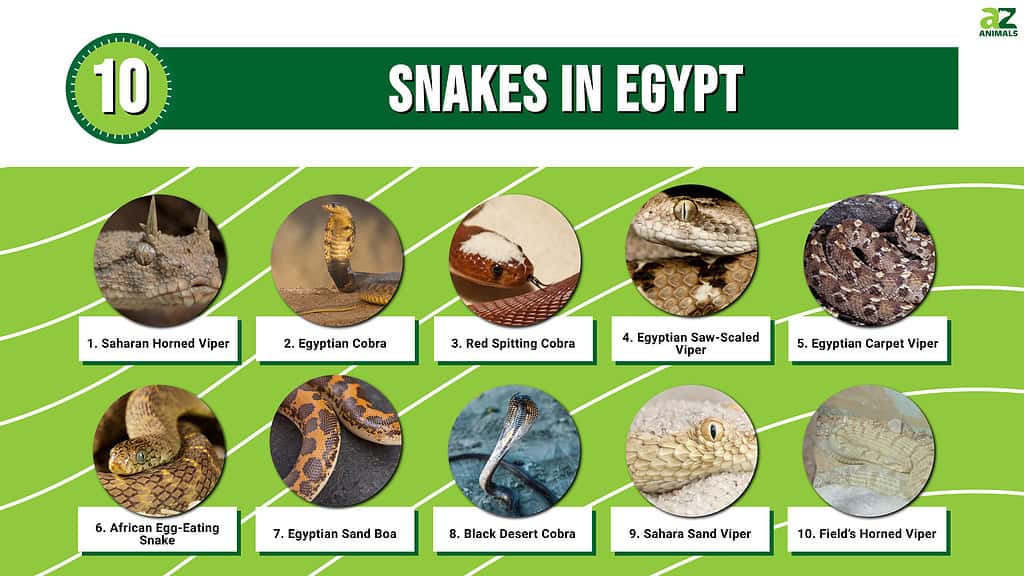
Read on to learn about ten of the coolest snakes in Egypt.
1. Saharan Horned Viper
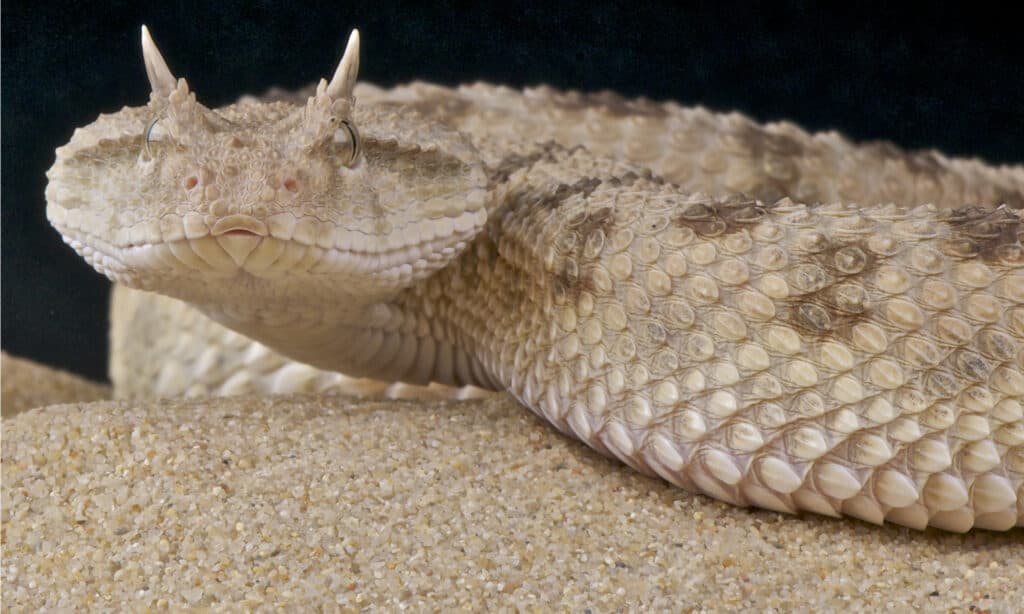
Saharan horned vipers have ‘horns’ that stick up from above their eyes.
©reptiles4all/Shutterstock.com
These venomous vipers are best known for the ‘horns’ that stick straight up from just above their eyes. They’re sand-colored, with a variegated pattern of light and dark brown scales. Desert horned vipers grow to a maximum length of three feet and eat mostly rodents and small birds. They move by sidewinding, a type of movement in which they move sideways by curving and straightening their bodies. Saharan horned vipers are one of the most common snakes in Egypt.
2. Egyptian Cobra
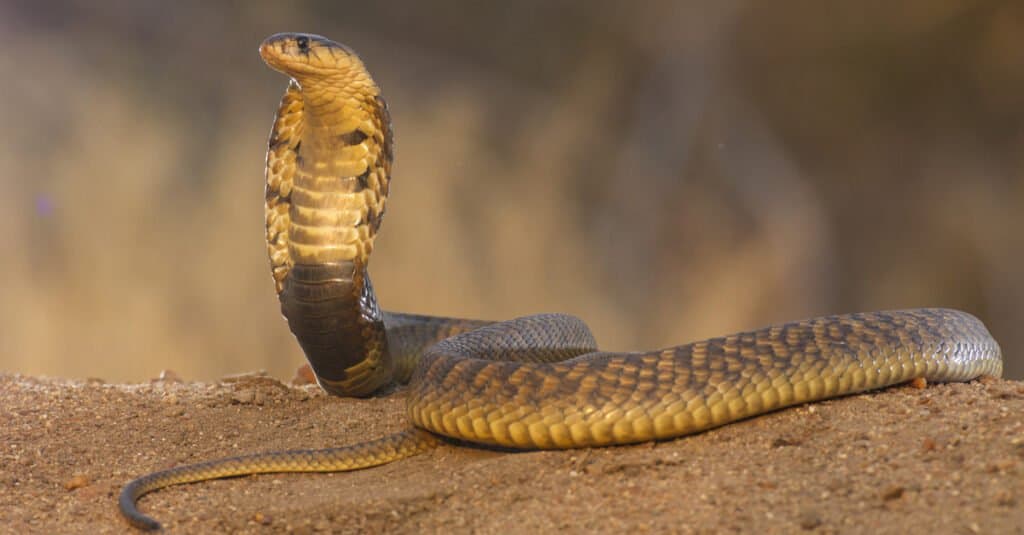
Egyptian cobras usually grow to around five feet long, with some recorded at eight feet.
©Stu Porter/Shutterstock.com
Egyptian cobras are one of the deadliest snakes in Egypt. Adults range from dark brown to dark red to black. They have large hoods and usually grow to around five feet long, though some have been recorded at over eight feet long. Egyptian cobras eat mainly amphibians, birds, rodents, and reptiles. They’re generally nocturnal, though they come out in the daytime to sun themselves. Egyptian cobras have round pupils, unlike species of viper, which have elliptical pupils, and don’t spit venom.
3. Red Spitting Cobra
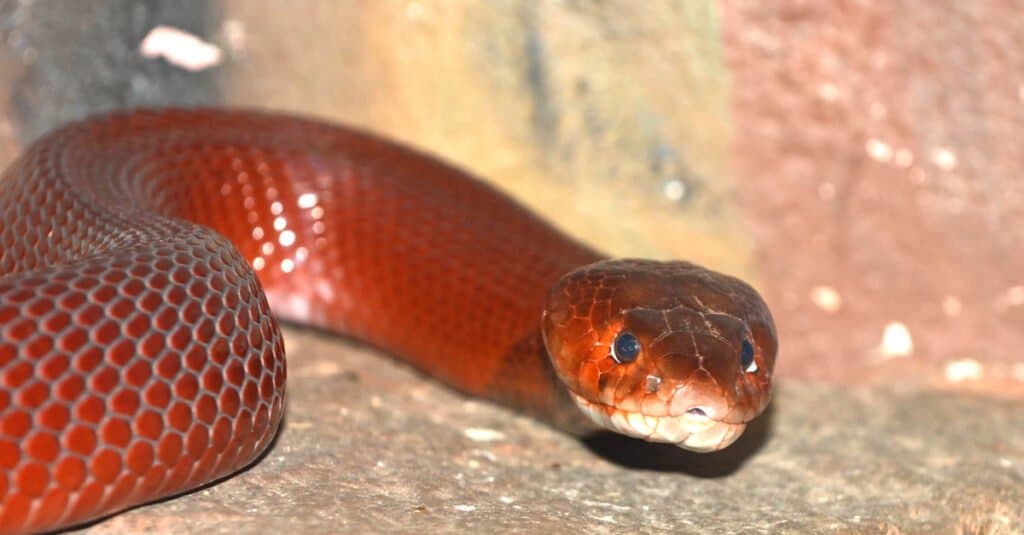
Red spitting cobras can spit venom accurately up to eight feet away.
©mountainpix/Shutterstock.com
Red spitting cobras can spit venom accurately up to eight feet away. Even more terrifying, they can spit more than 20 times a minute. That’s impressive, considering these snakes grow to a maximum length of five feet. They’re mainly red to red-orange, with black markings at the throat. Their diet consists primarily of reptiles, amphibians, and rodents. Red spitting cobras have round pupils and a wide hood like Egyptian cobras. These snakes rear up, flatten their hoods, and spit venom when threatened. They don’t cause many human deaths, but their venom can cause blindness if it gets into the eyes.
4. Egyptian Saw-Scaled Viper
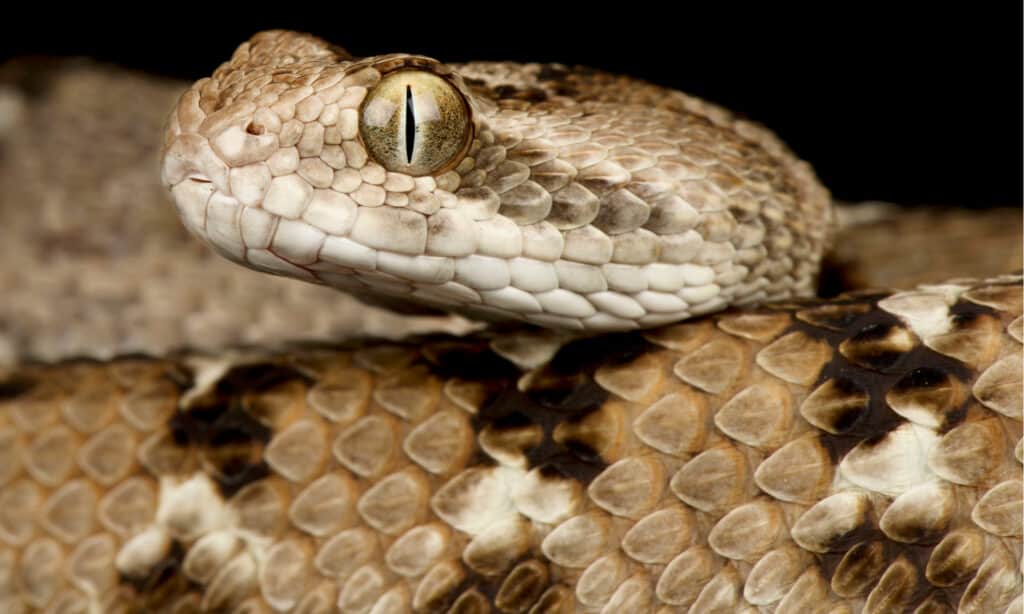
Egyptian saw-scaled vipers rub their scales together to produce a warning sound.
©reptiles4all/Shutterstock.com
Egyptian saw-scaled vipers are one of the most venomous snakes in Egypt. They get their name from the way they rub their scales together to produce a warning sound. These snakes grow up to three feet long. They look similar to rattlesnakes, with bands of diamond markings across their bodies. Egyptian saw-scaled vipers eat insects, amphibians, reptiles, birds, and rodents. Unlike many species of snakes, Egyptian saw-scaled vipers are known to be aggressive and won’t hesitate to bite a human. Most bites occur after dark, as these snakes are mostly nocturnal.
5. Egyptian Carpet Viper
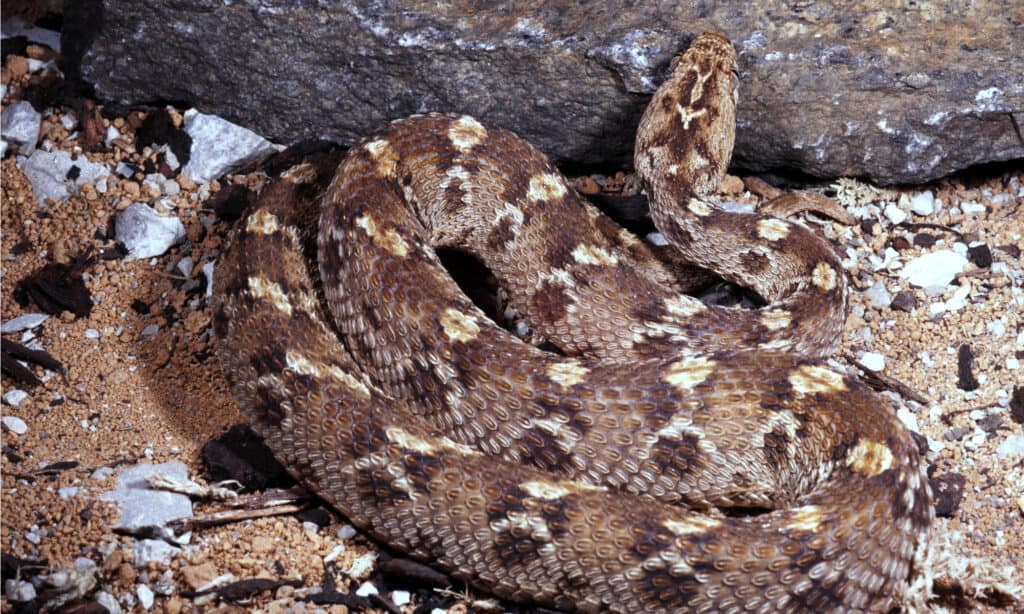
Egyptian carpet vipers grow to a maximum length of 2.5 feet.
©Vladislav T. Jirousek/Shutterstock.com
These snakes are closely related to Egyptian saw-scaled vipers. They grow to a maximum length of 2.5 feet and have sand-colored bodies with variegated markings. Their diet consists mainly of insects, amphibians, and rodents. Like Egyptian saw-scaled vipers, Egyptian carpet vipers have highly toxic venom, and bites can cause fatalities in humans.
6. African Egg-Eating Snake

African egg-eating snakes eat only eggs.
©Joe McDonald/Shutterstock.com
African egg-eating snakes are one of the only snakes in Egypt that exclusively eats eggs. They can even slither up trees to raid the nests of birds. These snakes grow up to four feet long and have brown backs with pale bellies. They’re non-venomous and present no danger to humans. When threatened, African egg-eating snakes coil their scales together to produce a rasping sound, similar to Saharan horned vipers.
7. Egyptian Sand Boa
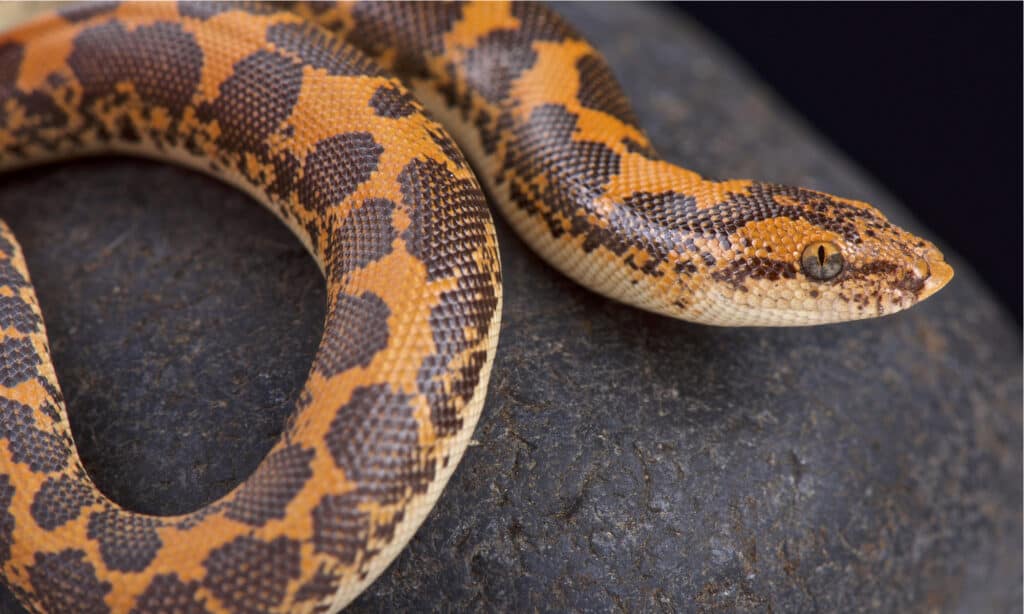
Egyptian sand boas are also known as Kenyan sand boas.
©reptiles4all/Shutterstock.com
Egyptian sand boas are one of the shortest, thickest snakes in Egypt. Females grow up to two feet long, while males rarely exceed 15 inches long. These snakes are yellow with dark brown splotches. They resemble nothing so much as a bruised banana. Egyptian sand boas aren’t venomous; instead, they constrict their prey. These snakes eat mostly small mammals. They present little danger to humans, though they will bite to defend themselves.
8. Black Desert Cobra
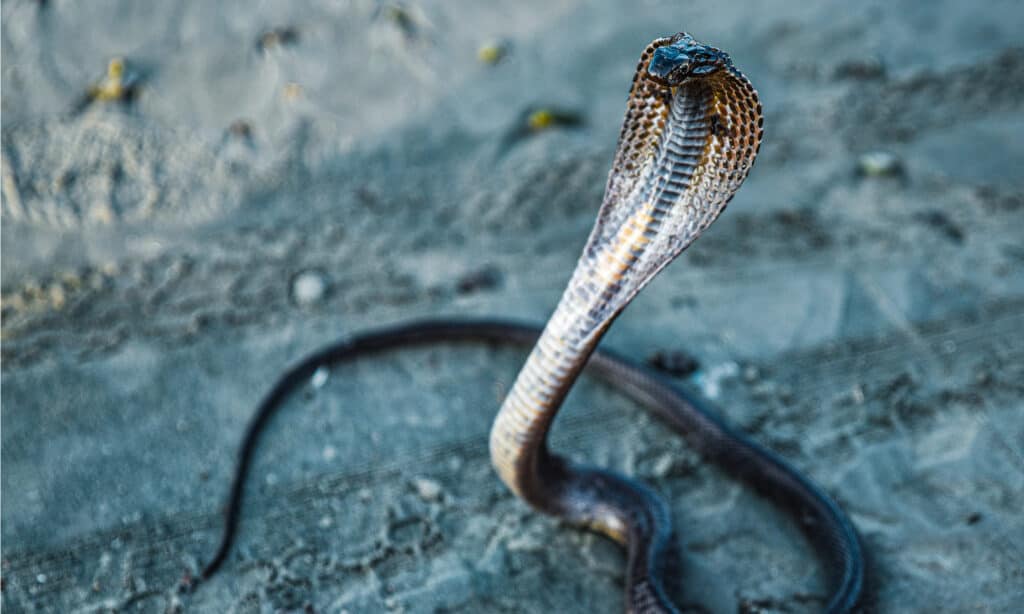
Black desert cobras are one of the deadliest snakes in Egypt.
©Syed Usman Zaidi/Shutterstock.com
Black desert cobras are one of the deadliest snakes in Egypt. They can reach lengths of nearly six feet. Their coloring is entirely black or very dark brown, and they have pure black eyes. They eat mostly reptiles, amphibians, rodents, and birds.
9. Sahara Sand Viper

Sahara sand vipers have a maximum length of one foot.
©reptiles4all/Shutterstock.com
Sahara sand vipers are one of the smallest venomous snakes in Egypt. They top out at around one foot long. They’re sand-colored with light brown splotches and a wide head. They primarily feed on small lizards and present little danger to humans.
10. Field’s Horned Viper

Field’s horned vipers grow to a maximum length of two feet.
©SuperJew, CC BY-SA 3.0 <https://creativecommons.org/licenses/by-sa/3.0>, via Wikimedia Commons
These heavy-bodied, venomous snakes grow to a maximum length of two feet. They’re sand-colored with light brown splotches and triangular heads. Like Saharan horned vipers (which they’re closely related to), they have horns above their eyes. These snakes mainly eat rodents.
Summary Of The 10 Snakes In Egypt
| # | Snake |
| 1 | Saharan Horned Viper |
| 2 | Egyptian Cobra |
| 3 | Red Spitting Cobra |
| 4 | Egyptian Saw-Scaled Viper |
| 5 | Egyptian Carpet Viper |
| 6 | African Egg-Eating Snake |
| 7 | Egyptian Sand Boa |
| 8 | Black Desert Cobra |
| 9 | Sahara Sand Viper |
| 10 | Field’s Horned Viper |
Other Dangerous Animals Found In Egypt
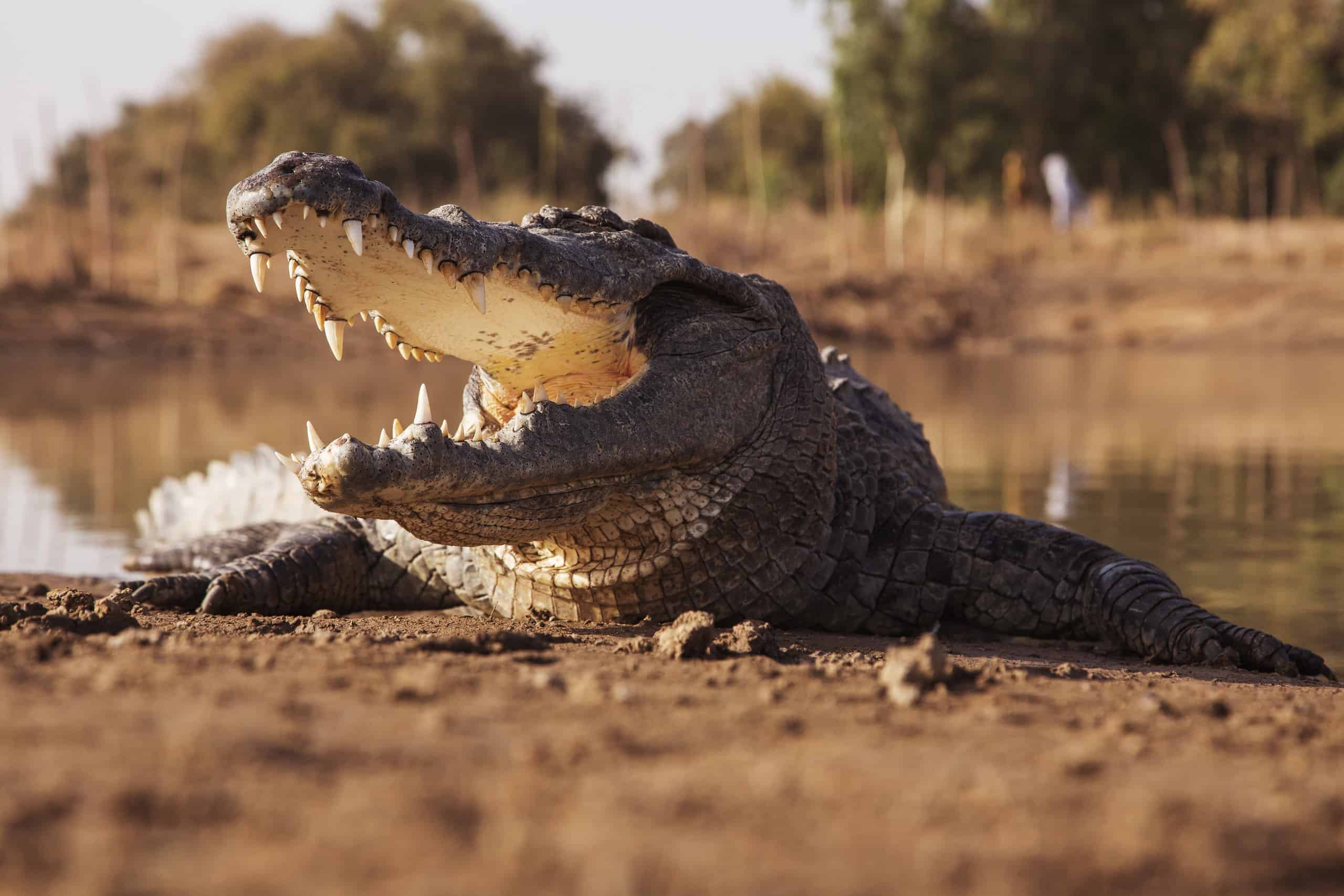
A Nile
crocodile
on the river banks
©StanislavBeloglazov/Shutterstock.com
One of the most deadliest and dangerous animals found in Egypt is the Nile crocodile. Weighing up to 1000 pounds, this apex predator is very aggressive and should be avoided at all costs when visiting the Nile as it does not need to be provoked to attack. Endemic to freshwater habitats, this reptile is estimated to be responsible for 200 deaths per year, although many deaths are not reported and it is possible that these numbers may be higher.
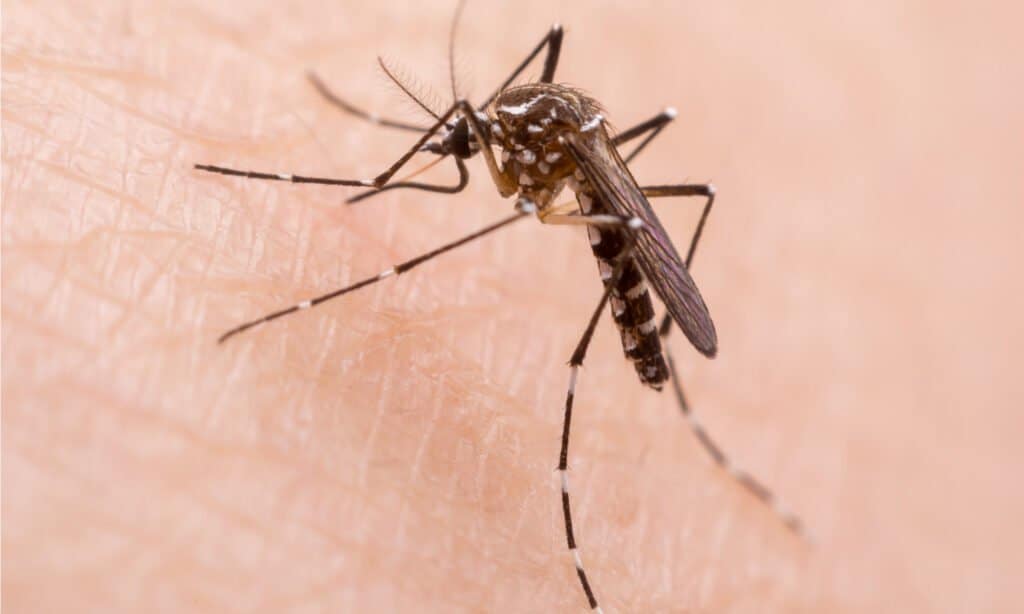
Mosquitoes are known for being carriers of some of the most dangerous parasitic diseases.
©Surachai Pung/Shutterstock.com
The tiniest of animals is also the most dangerous – the mosquito. Egypt can count at least five recorded common mosquito-borne viruses – Chikungunya virus, Rift Valley fever virus, West Nile virus, Dengue fever, and Sindbis virus but it doesn’t stop with those. This insect also carries malaria, yellow fever, Zika, and Japanese encephalitis. Adult mosquitos live for around 2 to 4 weeks and only the females bite people and animals. It is highly recommended that you wear bug repellent and clothes with long sleeves.
The photo featured at the top of this post is © Julian W/Shutterstock.com
Discover the "Monster" Snake 5X Bigger than an Anaconda
Every day A-Z Animals sends out some of the most incredible facts in the world from our free newsletter. Want to discover the 10 most beautiful snakes in the world, a "snake island" where you're never more than 3 feet from danger, or a "monster" snake 5X larger than an anaconda? Then sign up right now and you'll start receiving our daily newsletter absolutely free.
Thank you for reading! Have some feedback for us? Contact the AZ Animals editorial team.






